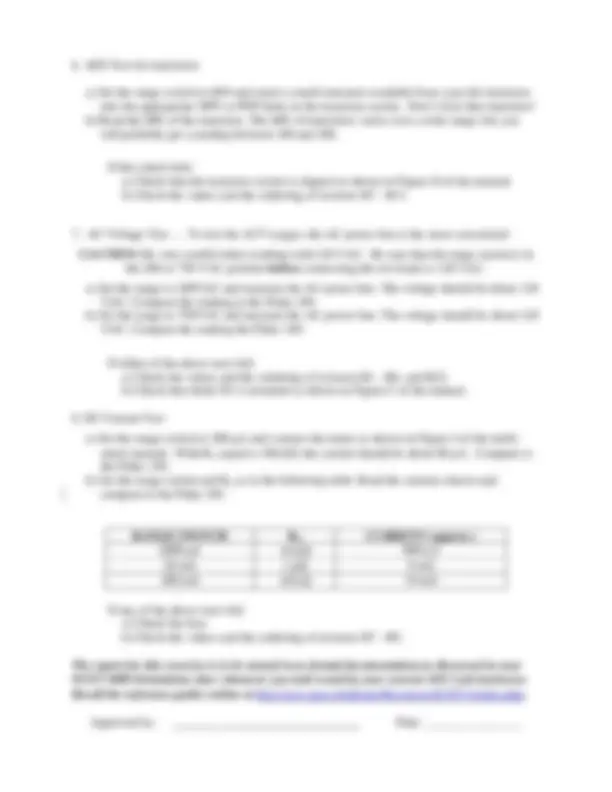



Study with the several resources on Docsity

Earn points by helping other students or get them with a premium plan


Prepare for your exams
Study with the several resources on Docsity

Earn points to download
Earn points by helping other students or get them with a premium plan
Community
Ask the community for help and clear up your study doubts
Discover the best universities in your country according to Docsity users
Free resources
Download our free guides on studying techniques, anxiety management strategies, and thesis advice from Docsity tutors
A laboratory exercise for assembling, calibrating, and testing a multi-meter using various test measurements and the hp3612 power supply and fluke 189 digital multimeter (dmm). The exercise includes a procedure for calibrating the multi-meter's analog to digital converter and testing its dc voltage, resistance/diode, hfe for transistors, ac voltage, and dc current capabilities. The report for this exercise is to be turned in as formal documentation.
Typology: Lab Reports
1 / 3

This page cannot be seen from the preview
Don't miss anything!


ECET 1011–Laboratory Exercise # 11 Multi-meter Calibration
Name Lab Section Date
Overview and Introduction:
This laboratory’s focus is for you to finish assembling your multi-meter. Make certain to clear enough space on the lab bench so as not to have any equipment in danger of the solder iron. Be sure to ask questions and remember that the time is running out to finish your multi-meter by the end of the term! Also, be sure to bring your assembly and instruction manual (of which most of this lab is derived) along with all associated parts that came with your multi-meter kit. If you are missing any components, remedy this ASAP! In addition, you will need the HP3612 Power Supply and a Fluke 189 Digital MultiMeter (DMM) to perform a variety of test measurements and assist in calibrating your own personal multi-meter.
Your ability to measure and record your data in a neat and organized manner is important. Start a habit of being professional by using a lab notebook and generating tables.
If any of these tests fail: a) Check that the battery is good. b) Check the values of resistors R18 - R20, R24, and R25. c) Check the values of capacitors C1 - C6. d) Check the PC board for solder bridges and bad solder connections. e) Check that the slide contactors are seated correctly. f) Check that the LCD and zebras are seated correctly.
Refer to the METER OPERATION section of the multi-meter manual for test lead connections and measurement procedures. Turn the range selector switch to the 20 V position and connect the test leads. Set your HP power supply to 15.3 volts. Using the Fluke 189 meter, measure this DC voltage. Calibrate the kit meter by measuring the same voltage and adjusting potentiometer R16 until the kit meter reads the same as the Fluke meter. When the two meters agree, the kit meter is calibrated. Turn the knob to the OFF position and remove the voltage source. If the calibration fails: a) Check the PC board for solder bridges and bad solder connections. b) Check the values and the soldering of resistors R7 - R9, R15, R17, R21, R23, potentiometer R16, and capacitor C3.
Using the HP variable power supply, set the supply to about the midpoint of each of the meter’s DCV ranges and compare the kit meter reading to the Fluke 189 meter. Make sure to measure a negative voltage. Perform the following two tests: a) Set the range switch to 2000 mV and measure the voltage across the 100 ohm resistor of the circuit shown in Figure Ia of the multi-meter manual. You should get about 820 mV. Compare this with the Fluke 189. b) Set the range switch to 200 mV and measure the voltage across the 100 ohm resistor of the circuit shown in Figure Ib in the multi-meter manual. You should get about 90 mV. Compare this value with the Fluke 189. If any of these tests fail: a) Recheck the meter calibration. b) Check the values and the soldering of resistors R1-R6, R12-R17, R21-R24, and capacitor C3.
a) Measure a resistor of about half of the full scale value of each resistance range. Compare the kit meter readings to those from the Fluke 189. b) Measure the voltage drop of a good silicon diode. You should read about 700 mV. Power diodes and the base to emitter junction of power transistors may read less. If any of these tests fail: Check the values and the soldering of resistors R1 - R6, and R12.